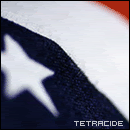You will find that no matter how closely you pack them, you will have gaps in between them.
There are only three objects which you can pack together which will leave no gaps: triangles, squares (rectangles), and hexagons.
Now let's say you have a bunch of equilateral triangles which are 4 inches on each side. That's 12 inches of wall (perimeter) around each triangle.
The formula for the area inside an equilateral triangle is:

In this case, a=4.
So the area of an equilateral triangle with a 12 inch perimeter is 6.93 inches.
Squares are easy. If you have a square that is 3 inches on each side, that is also a 12 inch perimeter. And the formula for the area inside a square is to simply multiply two sides.
So the area of a square with a 12 inch perimeter is 9 inches.
Now take a hexagon where each side is 2 inches, for a total of 12 inches on the perimeter.
The formula for the area of a hexagon is:

In this case, t=2.
So the area of a hexagon with a 12 inch perimeter is 10.39 inches.
It should be clear now that when you have a given perimeter (12 in this case), the more sides you have, the more area you achieve. This intrinsic equation of a circle tells us that a circle will have the maximum amount of area for a given perimeter.
But circles leave gaps when packed together. So for purposes of packing and storage, the hexagon is the ideal shape.
Moving on...
To make one pound of wax for their nest, bees have to use six to eight pounds of honey.
To make one pound of honey, bees have to visit approximately two million flowers.
One pound of beeswax therefore requires worker bees to fly the equivalent of 12 times around the Earth!
Beeswax is therefore extremely labor intensive. So it is imperative to bees that they find the most efficient use of it for storing honey.
I give you, the hexagon honeycomb...

.






